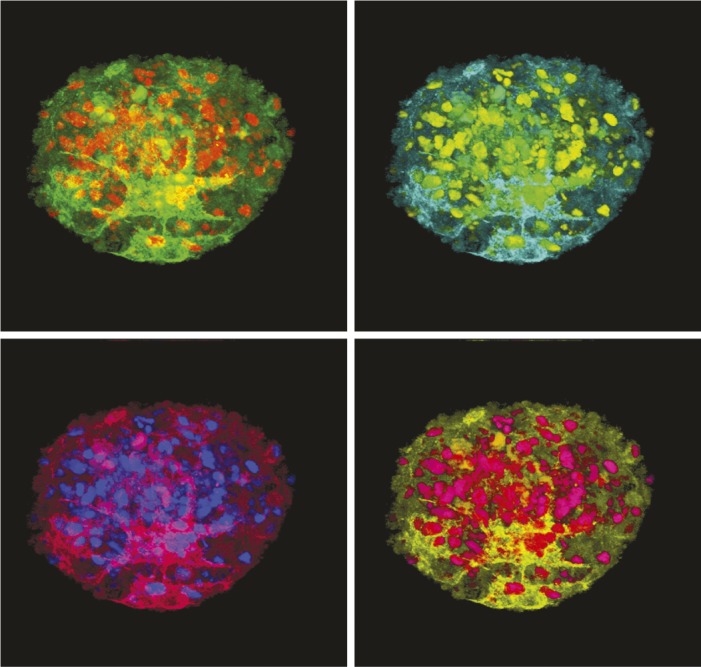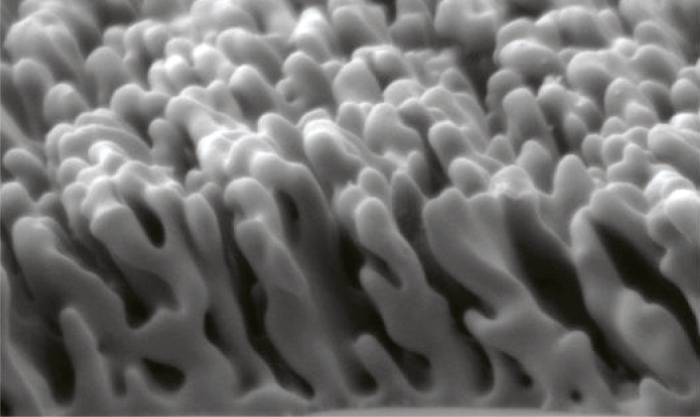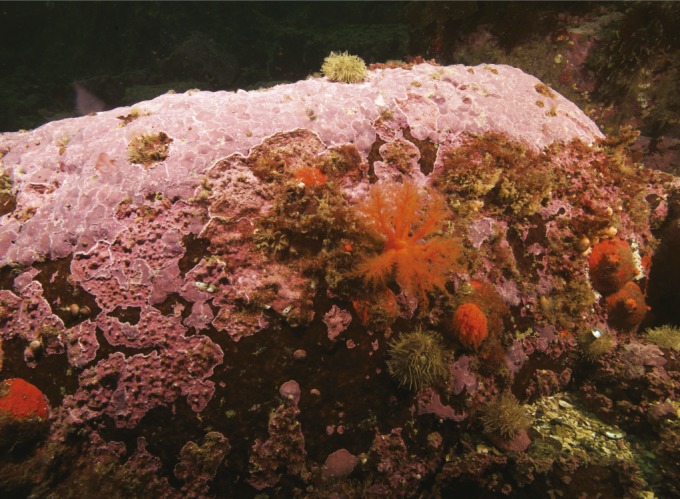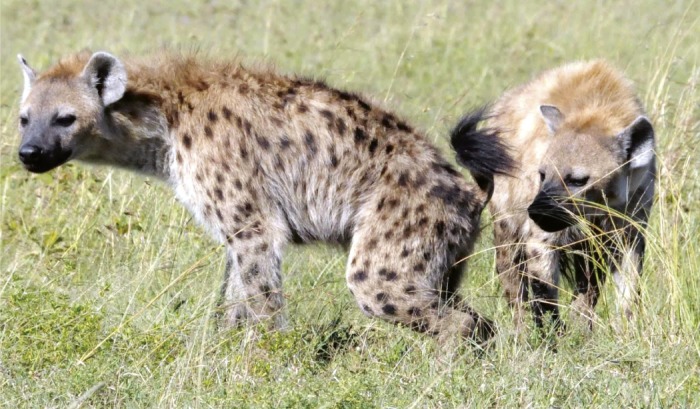Triggering human hair follicle growth

Top left panel shows a human dermal papilla spheroid, expres-sing syndecan 1 (green) with propidium iodide (red) marked nuclei. The Warhol theme reflects the potential of dermal spheroids to be mass-produced to create multiple new hair follicles.
Researchers have established that adult rodent dermal papillae, which control hair follicle growth, can be grown in the laboratory, transplanted into recipient skin, and made to trigger new hair follicles and fibers. Yet more than 4 decades later, a similar feat—using lab-grown human hair follicle dermal cells to trigger the growth of human hair—has remained elusive. Claire Higgins et al. (pp. 19679–19688) performed gene expression analysis on cultured human dermal papilla cells and found that growth in standard monolayer cultures alters the cells’ gene expression profiles. Hence, the authors used hanging drop cultures to induce the aggregation of dermal papilla cells from seven human donors, inserted the resulting 3D dermal spheroids between the epidermis and dermis of neonatal foreskin in laboratory dishes, and grafted the recombined structures onto the backs of mice. The authors report that the 3D culture conditions helped partially restore the cells’ normal gene expression signatures and hair-inducing properties: After 6 weeks of implantation, new hair follicles from five of the seven donors were seen in the implanted skin. Microarray analysis revealed that 22% of gene transcripts perturbed by 2D culture were restored by growth as spheroids. Further, the authors identified an array of gene switches that control signaling mechanisms underlying hair development. Further studies might reveal whether dermal papilla spheroids represent a promising approach to human hair restoration, but the findings suggest that the spheroids might help to discover drugs that affect hair papilla function and to predict clinical responses to hair loss treatments, according to the authors. — P.N.
Light-directed nanoscale patterns grown on selenium-tellurium films

Nanoscale lamellae grow toward the illumination source.
Plants grow toward a source of illumination through a process called phototropic growth, which uses feedback between the light source and photosensitive hormones that help curve the plant’s stem. Recently developed photoresponsive materials, with chemical or physical properties that change under illumination, offer intriguing possibilities for using this biological strategy to synthesize complex, microscopic 3D structures. Bryce Sadtler et al. (pp. 19707–19712) describe an adaptive inorganic system that dynamically alters its nanoscale morphology in response to changes in illumination. The authors describe experiments in which ordered, complex nanoscale lamellar patterns spontaneously emerge during electrodeposition of selenium–tellurium films, grown under uniform illumination on unpatterned substrates in an electrolyte solution. These inorganic nanostructures exhibited phototropic growth, the authors report, with lamellar stripes that grew toward the incident light source at a rate that scaled with increasing light intensity. Furthermore, the patterns responded dynamically to illumination changes, allowing the authors to produce woodpile, spiral, branched, and zigzag structures. The findings demonstrate an approach that can rapidly produce nanostructures with different geometries, sizes, and orientations directly on top of one another, according to the authors. — T.J.
Estimating gas production from shale formations
Estimates of shale gas production have primarily relied on models established for conventional oil and gas wells, which have a different geometry from the horizontal wells in gas-rich shale. Tad Patzek et al. (pp. 19731–19736) analyzed the simplest model of gas production from horizontal wells that is consistent with the basic physics and geometry of the gas extraction process. The authors report that gas production from newly completed wells should initially decline at a rate that is inversely proportional to the square root of the time the well has been in production; eventually, gas diffusion causes the pressure in the well to drop, and gas production decreases exponentially. The authors compared their model with gas production data for more than 8,000 wells in the Barnett Shale in Texas, and found that it accurately predicted the behavior of approximately 2,000 wells in which production had begun to decrease exponentially within the last 10 years. The remaining 6,000 wells were too new for the model to predict when exponential decreases would set in, but the model enabled the authors to establish upper and lower bounds for well lifetime and the amount of gas that will be produced by the wells. According to the authors, the production forecasts might become increasingly accurate as more data become available. — N.Z.
Algal archive of Arctic sea-ice

Thick crusts of the sea-floor alga Clathromorphum compactum, found in coastal regions of the North Atlantic, North Pacific, and Arctic Ocean, where it can live for hundreds of years. Copyright 2010 Nick Caloyianis/Nick Caloyianis Productions, Inc.
Satellite observations of summer Arctic sea-ice cover extend back only a few decades, hampering climate modelers’ attempts to simulate centuries of climate variation. Jochen Halfar et al. (pp. 19737–19741) discovered that a species of sea-floor algae, Clathromorphum compactum, preserves sea ice cover records within its calcified crusts much like trees preserve precipitation history within their annual rings. The algae grow successive layers of calcite each year as sunlight is available. Photosynthetic growth then slows and stops when sea ice covers the ocean and blocks the sun. Seawater temperature is also preserved in the algae’s mineral layers as a ratio of magnesium to calcium, which is archived only during photosynthetic growth periods. The long life of the algae—up to 650 years—enabled the authors to reconstruct a record of summer sea ice cover dating back to around 1400 using calcite growth rates and Mg/Ca ratios as proxy measurements. The authors suggest that during the Little Ice Age, which lasted from the mid-16th to the mid-19th century, Arctic sea ice cover displayed year-to-year variability but overall stability, as deduced from C. compactum crusts. Since 1850, however, variability in sea ice cover has formed a multidecade declining trend, according to the authors. — P.G.
Microbes may aid hyena communication

Spotted hyena marking grass stalks with scent secretions (“paste”) from its specialized scent pouch draws the attention of a clanmate.
Many animals communicate using odorous secretions from scent glands. The fermentation hypothesis for mammalian chemical communication posits that symbiotic bacteria in the scent glands of mammals generate odorous metabolites that are used by their hosts to communicate. To investigate this hypothesis, Kevin Theis et al. (pp. 19832–19837) surveyed the bacterial communities in the scent glands of wild spotted and striped hyenas in Kenya using genetic sequencing and analyzed the odor profiles of scent gland secretions, known as pastes, collected from both species. The authors found that the bacterial communities in the scent glands and pastes of spotted and striped hyenas were different from each other, but each was dominated by fermentative, odor-producing bacteria. In addition, the structures of the bacterial communities varied with the profiles of odorous, volatile fatty acids in the pastes of both hyena species, the authors report. Within a clan of spotted hyenas, the profiles of bacteria and fatty acids in pastes differed between males and females, and varied with female reproductive state. The findings suggest that symbiotic bacteria underlie species-specific odors in both spotted and striped hyenas, and sex- and reproductive state–specific odors among spotted hyenas, according to the authors. — N.Z.
Correcting the errors of high-throughput sequencing at low cost
High-throughput DNA sequencing is a powerful tool that can be used to decipher segments of an organism’s genetic code, but the technology is plagued by a high error rate. The random misidentification of DNA bases makes it difficult to determine whether rare genetic variants are real, and restricts sequencing studies to relatively small chunks of DNA such as a single chromosome, the transcriptome, or mitochondrial DNA. Dianne Lou et al. (pp. 19872–19877) unveil a robust strategy for correcting such errors: a method named “circle sequencing.” The strategy converts linear DNA templates into circular structures, copies the templates multiple times in tandem using a rolling-circle polymerase enzyme, and sequences the products on a high-throughput sequencing machine. All copies of the circular sequence are then processed to create a single consensus sequence. The authors tested the method using the Illumina MiSeq sequencing platform and observed error rates comparable to a highly accurate but low-throughput sequencing method known as Sanger sequencing. According to the authors, circle sequencing offers higher efficiency and lower cost than existing strategies for correcting sequencing errors and could prove valuable in efforts to detect variation in complex samples such as tumors, microbial populations, and environmental communities. — A.G.


